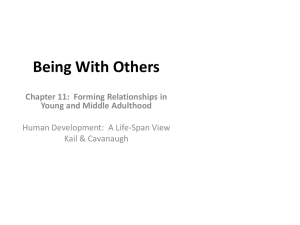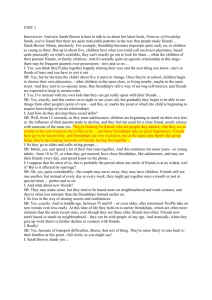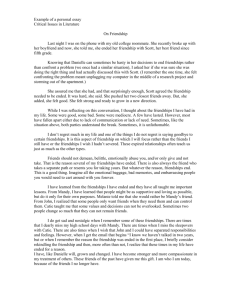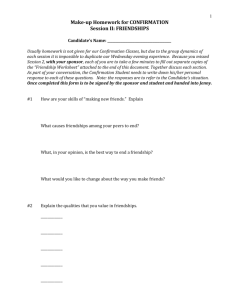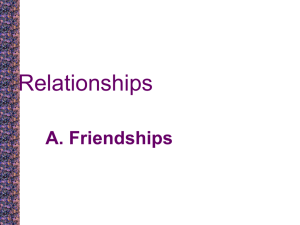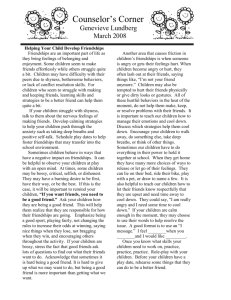Document 9915785
advertisement
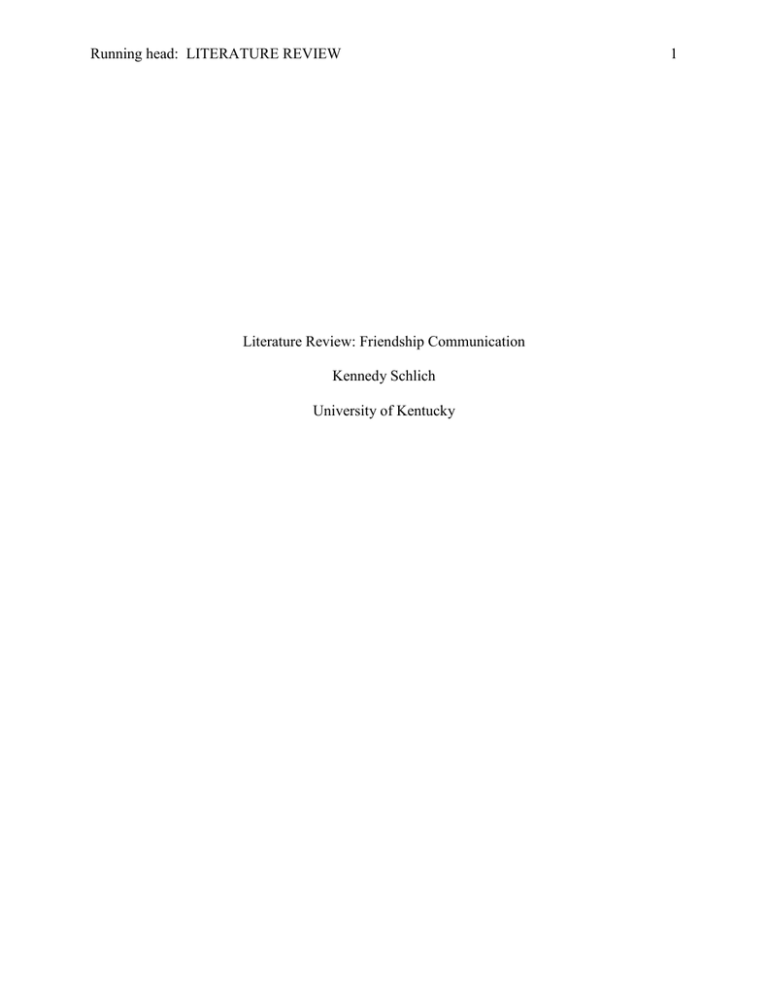
Running head: LITERATURE REVIEW Literature Review: Friendship Communication Kennedy Schlich University of Kentucky 1 LITERATURE REVIEW 2 Abstract Many research studies have been conducted in order to study friendships and the reasons for why we create them. With the help of five scholarly articles and the findings from these research studies, my paper will go in-depth on these specific reasons for forming friendships, the two different types of friendships that exist, and how the communication differs in both of these types. Each article gives a different perspective on friendships and the communication that goes on in them. My paper will first explain the findings from the research studies I am using to evaluate friendships. Then I will review any limitations from my research and common themes among the five articles I am referring too. Lastly, I will discuss how future research on friendships may evolve. All of these findings will be tied in to the course concepts we learn in our COM 252 class. LITERATURE REVIEW 3 Literature Review: Friendship Communication Friendship is an important aspect of life that we all experience, but why do we seek to make friends? Research has been conducted to particularly focus on friendship and the reasons for forming friendships with other people. Many theories have been developed in regards to our reasoning behind making friendships. These theories and reasons can vary depending on the type of friendship that is being evaluated, either same-sex or cross-sex friendships, because communication contrasts in both of these two types. Friendships can be started due to many different reasons including the rewards we receive from our friendships (emotional, material, and health rewards) and specific interpersonal communication theories (Attraction Theory, Social Exchange Theory, and Predicted Outcome Value Theory). I have found through my research findings I am using to support my argument that friendships are much more complex than they may seem. When analyzing research that has been conducted in regards toward the reasoning behind forming friendships, I have found that there are three different rewards that our friendships provide for us. These rewards include emotional rewards, material rewards, and health rewards (Cushman & Cahn, 1985). Emotional rewards we receive from our friendships are emotional support, encouragement, and happiness. Material rewards include help if we are in need of money, food, shelter, or transportation. Health rewards include providing us relaxation/happiness, warding off negative effects of stress, and lowering depression/anxiety levels. These are three types of rewards that influence forming and maintaining friendships, but according to research, these aren’t the main reasons behind establishing a friendship with someone. Different communication theories have been developed in supporting why we create friendships with other people. LITERATURE REVIEW 4 The Attraction Theory explains why we are drawn to make friendships with the certain people that we do. To support this theory, there are four different types of attraction that influence us to create these friendships. The four types of attraction are interpersonal, physical, task, and social (Rawlins, 2008). Interpersonal attraction is any force that draws someone to form a friendship with someone. Physical attraction is making friends with people who you deem as attractive. Task attraction is being attracted to someone’s abilities and dependability. Lastly, social attraction is being attracted to personality. The Social Exchange Theory is another theory that drives us human beings to establish a friendship with another person. The Social Exchange Theory states that people seek to form and maintain relationships in which the benefits or rewards outweigh the costs. If the friendship with that person provides us with more rewards (like the ones I discussed previously) than it provides us costs, then that friendship is worth having and maintaining. The third theory that impacts us to create friendships is called the Predicted Outcome Value Theory. This theory predicts that we form friendships when we think the effort will be worth it. This theory can relate to the Social Exchange Theory because the effort to form a friendship with someone would be worth it to us if there were rewards or benefits we would receive from the friendship. If not, and there are more costs than rewards, it wouldn’t be worth our effort to form a friendship with that person and we wouldn’t. These reasons as to why we create friendships depend on what type of friendship we are attempting to form. One type of friendship is same-sex friendship. This is having a friendship with someone who is the same biological sex as you (woman with woman, man with man). Same-sex friendships among women have different communication styles than same-sex friendships among men. For women, the friendship puts more emphasis on conversation and expressing emotions. The conversation is more relational and emotionally or internally focused. LITERATURE REVIEW 5 For men, the communication in the friendship puts more emphasis on activities and shared interests. The conversation is focused on external things or activities such as sports, politics, etc. To support this argument, I found a study that was conducted by Lynne Davidson and Lucile Duberman to explore the similarities and differences between men and women in same-sex friendships. The participants of the study were 100 young people (40 male, 60 female) ranging from the ages of 18-28. All participants were of Caucasian race, had diverse religions, and the study took place in New Brunswick, NJ. This research study consisted of an interview using a questionnaire. The questionnaire consisted of questions asking about the participant’s “best friend.” The questions focused on three different content levels of the friendship the participant has with their “best friend.” These content levels are topical (non-intimate; conversations on external level), relational (conversations on interactional level), and personal (intimate; conversations on internal level). The findings of this study show that 60% of the male respondents found their content level to be topical, 10% claimed their content level as relational, and 30% found their content level to be personal. For the female respondents, 37% claimed their content level in their friendship as topical, 25% found their content level to be relational, and 38% found their content level to be personal. The findings of this study support that friendships in men dyads relate primarily on a topical level, while women dyads rely primarily on a personal level (Davidson & Duberman, 1982). Another type of friendship is cross-sex friendships. These are friendships with someone of the opposite biological sex (man and woman). These friendships allow for both individuals to see the world from the other sex’s perspective. You can obtain new views that you wouldn’t get from having friends of the same sex. In these friendships, men are able to express their emotions with women, something they wouldn’t do in their friendships with other men. Also, women are LITERATURE REVIEW 6 able to experience shared activities with men, activities that they wouldn’t experience in their friendships with other women. To support this argument, I found a research study that was conducted by Michael Monsour. The purpose of the study he conducted was to investigate how people in cross-sex friendships express intimacy towards each other. The participants of the study were 165 college students (53 male, 112 female) who were enrolled in communication courses. The study took place during the 1989-1990 academic school year. The ages of the participants ranged from 18-42, majority of the participants were between the ages of 18-29. The participants completed a survey asking questions about their cross-sex friendships with their “good friends” or friends they’d consider their “best friends.” The participants were asked questions about intimacy, what they believe intimacy means in their cross-sex friendships, and how they express it. The findings from this study show that self-disclosure was the most listed meaning for intimacy in both the male and female respondent’s cross-sex friendships. Also, males were found to list emotional expressiveness more frequently in their forms of expressing intimacy in friendships with the opposite sex, while women listed emotional expressiveness as less important in their friendships with the opposite sex (Monsour, 1992). These findings support my argument for the dynamics of cross-sex friendships. Men are more likely to be emotionally expressive with women and women are more likely to focus on shared activities with men. Although the research I have found supports my argument for communication in two different types of friendships and the reasoning behind the formation of friendships, there are still possible limitations from the research. The research I found on the personal rewards we receive when creating friendships and the communication theories that influence us to establish these friendships does not include particular studies that put this information to the test. Although there are many examples to back this research information up, this information should LITERATURE REVIEW 7 still be used in an actual study on actual participants to get even more accurate information on why we form friendships with people. Also, limitations from the research studies used to support my argument on same-sex and cross-sex friendships only focus on certain age groups (young adults). Maybe to get more accurate results, studies could be conducted on several different age groups, including adults or adolescents, because same-sex and cross-sex friendships would fluctuate in the types of communication and intimacy expressed depending on the age of the individuals. Although these limitations do exist, I believe the study groups were large enough and the authors were unbiased in their research. All five of my sources go in-depth on the importance of gender difference in friendships. For example, Davidson and Duberman showed me that men and women in same-sex friendships focus conversation on very different things (external vs. internal). Also, Monsour enlightened me that men and women in cross-sex friendships were more likely to express intimacy in an opposite way from which they would in same-sex friendships. Both of these examples stress the importance of gender differences in friendship, and prove that these gender differences reflect how the reasoning behind why friendships are formed can vary depending on whether the friendship is same-sex or cross-sex. My outside research I facilitated on communication in friendships can tie in to the concepts we have discussed in class lecture so far this semester in many different ways. The research I have found on friendships really correlates with the lecture we just had on interpersonal communication in close relationships. This lecture focused on intimacy. In this course, we define intimacy as being able to connect on a deep level with someone. There are four different types of intimacy: emotional, physical, intellectual, and shared activities. These course concepts relate to my research on friendships because in same-sex and cross-sex friendships, intimacy is expressed in different ways. For same-sex friendships among women, women LITERATURE REVIEW 8 express emotional intimacy. For same-sex friendships among men, men express shared activities intimacy. For cross-sex friendships, men express emotional intimacy with women, and women express shared activities intimacy with men. Intimacy is a huge factor in friendships and was the focus for the research studies I used to support my argument on different communication in different friendship types. Our lecture on intimacy specifically focused on how gender determines how we express intimacy differently, and this ties right in with the research I have found on friendships. Another course concept from class that ties in with my research would be the information I learned from our lectures focused on relationships and how they form. I learned that the reasons we look for a relationship with a certain person are based on appearance, similarity thesis, complementarity, Social Exchange Theory, competency, proximity, and disclosure. These reasons relate to my research because these reasons can also apply to why you choose to make friendships with certain people. Just like the information from our relationships lecture, I found in my research that the Social Exchange Theory also is a reason behind why we form friendships, not just relationships. Both our lectures on intimacy and relationships connect with the research I have found for my literature review. For future research on communication in friendships, this topic may or may not evolve in the next 10-20 years. I believe the topic wouldn’t evolve when it comes down to the conversation content in these friendships, I believe this research will stay the same. From facilitating research on communication in friendships, I have learned that friendships are created based on the emotional, material, and health rewards provided by the friendship, and theories such as the Attraction Theory, Social Exchange Theory, and Predicted Outcome Theory support why we seek these friendships. Through my research, I learned there are very many differences in the communication process in same-sex and cross-sex friendships. LITERATURE REVIEW 9 References Cushman, D., & Cahn Jr., D. (1985). Communication in interpersonal relationships. Albany, New York: State University of New York Press. Retrieved from http://books.google.com/books?hl=en&lr=&id=mlIUj3hgS7UC&oi=fnd&pg=PA1&dq=i nterpersonal communication in friendships&ots=rcFyq6o25l&sig=SpXmQi8MORP8QKKqfI1ZJ0wLxUs Davidson, L., & Duberman, L. (1982). Friendship: Communication and interactional patterns in same-sex dyads. Sex Roles, 8(8). Retrieved from http://link.springer.com/article/10.1007%2FBF00287852 Monsour, M. (1992). Meanings of intimacy in cross and same-sex friendships. Journal of Social and Personal Relationships, 9(2), 277-295. Retrieved from http://spr.sagepub.com/content/9/2/277.full.pdf html Nicotera, A. (1993). Interpersonal communication in friend and mate relationships. Albany, New York: State University of New York Press. Retrieved from http://books.google.com/books?id=Mk50F0ZAgOEC&pg=PA139&lpg=PA139&dq=Co mmunication in Interpersonal Relationships edited by Donald P. Cushman, Dudley D. Cahn&source=bl&ots=Y2Jf7_qzE5&sig=nDaK1zl__jdNOPfyaGnH1DeeAAY&hl=en&s a=X&ei=5yNYUoHqB_b-4APc94GQAQ&ved=0CEYQ6AEwBQ Rawlins, W. (2008). Friendship matters: Communication, dialectics, and the life course. New Brunswick, New Jersey: Transaction Publishers. Retrieved from http://books.google.com/books?hl=en&lr=&id=SHeGbAWzF44C&oi=fnd&pg=PR12&d q=communication in friendships&ots=vAMfMbN458&sig=uT-YW4kWYBduhKlIEug5kvxn2Y

